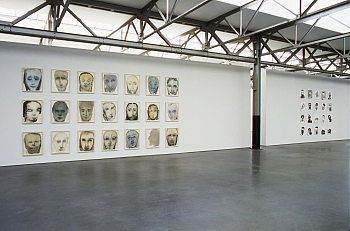The Marlene Dumas exhibition Name no Names has been organized by the Centre Pompidou, Musée national d’art moderne and is being shown in Tilburg following presentations in Paris and New York. It provides a broad survey of the artist’s work on paper–nearly one hundred drawings, collages and watercolors dating from the late seventies until 2002, including Black Drawings and Under the Volcano which are part of De Pont’s collection. Several paintings and a recent series of drawings titled Blindfolded have been added to the exhibition.
Drawings and watercolors are integral to the work of Dumas (Cape Town, 1953). They primarily involve figures and portraits that have been set down on the paper in a direct and apt manner. The exhibition shows various styles and techniques in her drawing. For Dumas, these are linked directly to the choice of subject matter. In early work she frequently used the collage technique; later work became more expressionistic and sometimes even cartoonish. These are often satirical comments on art criticism and artistry. Other works are characterized by a large scale and fluid forms of ink wash.
With her work Dumas often makes poignant remarks on ingrained role patterns and social relationships. During her youth in apartheid-divided South Africa, she herself experienced the way in which people tend to regard each other as ‘types’ rather than as individuals. In her work she speaks out on such prejudice. Black Drawings (1991-92) is comprised of 111 individual portraits. In this work Dumas deals with stereotypical divisions according to race and skin color, which allow no room for an appreciation of the individual.
The individual stance of Dumas as a woman artist does not remain unconsidered. Her series Defining in the Negative (1988) and Strong Works (1990) comment on the female’s traditional role as model, muse or mistress. She gives her drawings ironic captions such as ‘I won’t be hung upside down for Mr. Baselitz’ and ‘I won’t sleep in Mr. Fischl’s bed’. She allows the women, who literally bare themselves to voyeuristic gazes, to grin and look back confidently (Dorothy D-lite and Under the Volcano, 1998). Her women are not victims.
The woman’s role as mother is also the subject of many drawings where Dumas shows the other side of the carefree, idealized image in a humorous and mocking manner. Even the babies look disturbing, with their stunted bodily shapes (The Foetus Tree, 1987-91 and Baby Eating Its Own Tail, 1989). The drawings made by the artist shortly after the birth of her own child show, above all, the defenselessness of a newborn baby.
Sexuality is a recurrent theme in the work of Dumas. Recently she has produced a series of male nudes in pornographic portrayals (Pink Erection 1998, X-Plicit 1999 and Things Men Do 2001). The ‘explicit’ nudes do display a certain vulnerability however. The work of Dumas is often marked by this combination of bluntness and intimacy. To her, drawing has multiple and sometimes even conflicting functions: it heightens or obliterates the memory of reality.
The most recent work shown, Blindfolded 2002, involves a series of portraits of blindfolded Palestinian men. Dumas has produced them in response to the hopeless situation in the Middle East and the endless images of refugees, prisoners and victims shown in the media. For an artist whose work is often so centered around the eyes, around looking and seeing, the blindfold represents considerable degradation. Someone who is deprived of sight is subject to that of others.
During the exhibition the documentary film on Dumas, Miss Interpreted (1997), will be shown. Direction: Rudolf Evenhuis and Joost Verhey. Production: MM Filmprodukties in collaboration with de Humanistische Omroep. Duration: 63 minutes.
The accompanying catalogue contains texts by Jonas Storsve, curator of the Cabinet d’Art Graphique and compiler of the exhibition, as well as a text written by Marlene Dumas herself.
